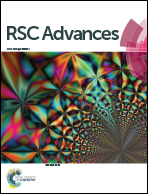Immobilizing CdS nanoparticles and MoS2/RGO on Zr-based metal–organic framework 12-tungstosilicate@UiO-67 toward enhanced photocatalytic H2 evolution†
Abstract
The robust UiO-67 framework was selected as a platform to incorporate 12-tungstosilicic acid (SiW12). The LUMO potential of the resulting SiW12@UiO-67 is observed to be −0.29 V versus NHE and the HOMO potential can be calculated to be 3.21 V vs. NHE. The SiW12@UiO-67 was firstly used as a supporting matrix to support the CdS nanoparticles and MoS2/reduced graphene oxide (M/G) cocatalyst. The obtained composite SiW12@UiO-67/M/G–CdS showed improved photocatalytic H2 evolution activity. The optimum H2 production over SiW12@UiO-67/M/G–CdS can be obtained when 30 wt% SiW12@UiO-67 is introduced in the composites, reaching 1.27 mmol h−1 in the presence of 5% M/G, which is about 2 times that of M/G–CdS. The enhanced photocatalytic activity might be attributed to the large specific surface area of SiW12@UiO-67 and the effective heterostructure between SiW12@UiO-67 and CdS. In addition, the insertion of SiW12 into the porous UiO-67 could improve its ability to transfer electrons. Therefore, the separation of photogenerated electrons and holes could be accelerated and the fast recombination of charge carriers of CdS could be suppressed.


 Please wait while we load your content...
Please wait while we load your content...